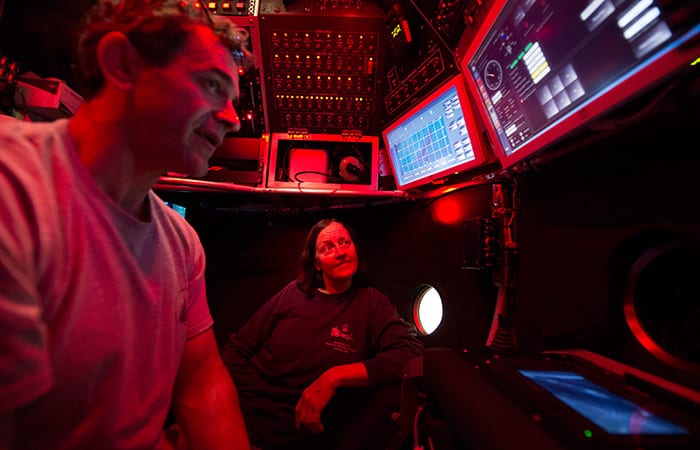
Rebuilding Alvin: Humphris & Strickrott
A series on the people who reassembled the iconic sub
From the beginning of 2011 to May 2013, Alvin, the U.S. science community’s only human-occupied submersible dedicated to deep-sea research, underwent a major overhaul and upgrade to greatly enhance its capabilities. In the end, the iconic sub was redesigned and rebuilt, piece by piece, by a one-of-a-kind team of engineers, technicians, and pilots at WHOI.
Susan Humphris, the WHOI scientist in charge of the upgrade project, and Bruce Strickrott, an Alvin pilot and Alvin Group Manager, explain extensive changes to the interior Alvin‘s personnel sphere, which carries a pilot and two observers to the seafloor.
Humphris: The diameter of the new sphere is 6.5, rather than 6, feet, which provides 18 percent more interior space. That doesn’t sound like a lot, but it makes a big difference.
Strickrott: I couldn’t stand up straight in the old Alvin when the hatch was shut.
Humphris: There’s more space for seating. In the old Alvin, we sat on the floor, except for the pilot, who sat on a metal box. But now I’m sitting on a curved bench with foam padding. This is quite comfortable, and it allows observers many more positions. They can sit with their legs into the sphere and look either through a side viewport or through one of the two new forward-looking viewports. Or they can lie down and look out a forward-looking viewport. Before, there was only one forward-looking viewport, for the pilot.
The additional forward viewports allow pilots and observers to see the same thing at the same time. Imagine in the past, me looking through a viewport on the side, and the pilot looking forward, and neither of us could see what each other was seeing. There’s none of this, ‘Could you turn the sub around so I can see something again?’ or ‘Could you let me crawl in your seat and show you what I want to sample?’
I spent part of my first dive in the new Alvin looking out the side viewports to try to remember what it was like in the old sub. I couldn’t believe I’ve done so many other dives just peering out the side viewports and not being able to see out the front of the vehicle, not being able to see what the pilot sees. It’s going to change the whole way we’re going to use the vehicle.
Strickrott: The new forward viewport windows are 7 inches wide. The old one was 5 inches wide. You couldn’t share a window before, because they were too small. Now I can even look over and see out of Susan’s viewport, without actually having to cram my face into her window, so we can see things together.
We paid a lot of attention to ergonomics. It was a collaborative effort. We brought in scientists to sit in the sphere and tell us what they thought. The pilots expressed their concerns and recommended what could be done better.
Humphris: You’ve got three bodies, three heads, six shoulders at the forward part of the sub for up to eight hours. You can imagine that could get a bit too cozy. But the seating arrangement has made it comfortable for three people to work together easily. It’s really a team effort down here to get all the observations and work you want done.
Strickrott: All the thought that went into the layout is paying off. There’s now a reasonable amount of room so folks can move around a little. Things are not right up in your face but are still within easy reach. We even got a real seat to replace our old metal box.
Alvin is owned by the U.S. Navy and operated by WHOI. The current upgrade was funded largely by the National Science Foundation, with support from private donations to WHOI.
From the Series
Related Articles
- The story of a “champion” submersible
- Robots to the Rescue
- Who is Alvin and what are sea trials?
- 7 Places and Things Alvin Can Explore Now
- The story of “Little Alvin” and the lost H-bomb
- Meet the Alvin 6500 Team: Lisa Smith
- Overhaul to take Alvin to greater extremes
- Meet the Alvin 6500 Team: Rose Wall
- Racing an undersea volcano
Featured Researchers
See Also
- Newly Upgraded Alvin Submarine Passes Scientific Sea Trials WHOI media release
- Alvin Science Verification Cruise Expeditions & Blogs
- Building the Next-Generation Alvin Submersible Oceanus magazine
- Alving Gets an Interior Re-design Oceanus magazine
- National Deep Submergence Facility at WHOI
- Frequently Asked Questions about Alvin WHOI Ocean Instruments
- Alvin Upgrade
- Alvin's Pilots Oceanus magazine
